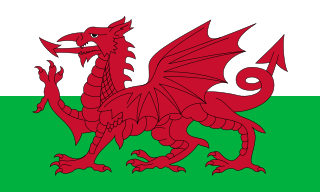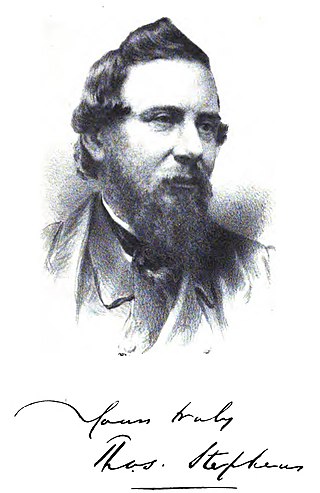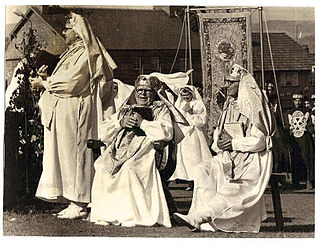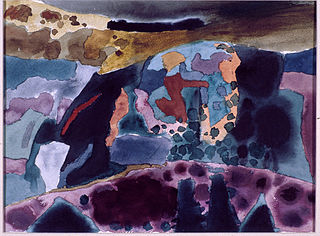
Brandenburg is a home rule-class city on the Ohio River in Meade County, Kentucky, in the United States. The city is 40 miles (64 km) southwest of Louisville. It is the seat of its county. The population was 2,894 at the 2020 census.

Cowbridge is a market town in the Vale of Glamorgan, Wales, approximately 12 miles (19 km) west of the centre of Cardiff.

In Welsh culture, an eisteddfod is an institution and festival with several ranked competitions, including in poetry and music. The term eisteddfod, which is formed from the Welsh morphemes: eistedd, meaning 'sit', and fod, meaning 'be', means, according to Hywel Teifi Edwards, "sitting-together." Edwards further defines the earliest form of the eisteddfod as a competitive meeting between bards and minstrels, in which the winner was chosen by a noble or royal patron.
A constructed writing system or a neography is a writing system specifically created by an individual or group, rather than having evolved as part of a language or culture like a natural script. Some are designed for use with constructed languages, although several of them are used in linguistic experimentation or for other more practical ends in existing languages. Prominent examples of constructed scripts include Korean Hangul and Tengwar.

Ogham is an Early Medieval alphabet used primarily to write the early Irish language, and later the Old Irish language. There are roughly 400 surviving orthodox inscriptions on stone monuments throughout Ireland and western Britain, the bulk of which are in southern Munster. The largest number outside Ireland are in Pembrokeshire, Wales.

Edward Williams, better known by his bardic name Iolo Morganwg, was a Welsh antiquarian, poet and collector. He was seen as an expert collector of Medieval Welsh literature, but it emerged after his death that he had forged several manuscripts, notably some of the Third Series of Welsh Triads. Even so, he had a lasting impact on Welsh culture, notably in founding the secret society known as the Gorsedd, through which Iolo Morganwg successfully co-opted the 18th-century Eisteddfod revival. The philosophy he spread in his forgeries has had an enormous impact upon neo-Druidism. His bardic name is Welsh for "Iolo of Glamorgan".
Awen is a Welsh, Cornish and Breton word for "inspiration".

The National Eisteddfod of Wales is the largest of several eisteddfodau that are held annually, mostly in Wales. Its eight days of competitions and performances are considered the largest music and poetry festival in Europe. Competitors typically number 6,000 or more, and overall attendance generally exceeds 100,000 visitors, the highest recently being 186,000 attending the 2024 festival in Pontypridd. The 2018 Eisteddfod was held in Cardiff Bay with a fence-free 'Maes'. In 2020, the event was held virtually under the name AmGen; events were held over a one-week period.

Thomas Stephens was a Welsh historian, literary critic, and social reformer. His works include The Literature of the Kymry (1849,1876), Madoc: An Essay on the Discovery of America by Madoc ap Owen Gwynedd in the Twelfth Century (1858,1893), and Orgraff yr Iaith Gymraeg (1859), as well as a number of prize-winning essays presented at eisteddfodau between 1840 and 1858. He was the first Welsh historian and literary critic to employ rigorous scientific methods, and is considered to have done more to raise the standards of the National Eisteddfod than any other Welshman of his time. Stephens also figured prominently in efforts to implement social, educational and sanitary reforms both locally in Merthyr Tydfil and more broadly throughout Wales.

Sir (Albert) Cynan Evans-Jones CBE, more commonly known within Wales by his bardic name of Cynan, was a Welsh war poet and dramatist.

David Samwell was a Welsh naval surgeon and poet. He was an important supporter of Welsh cultural organisations and was known by the pseudonym Dafydd Ddu Feddyg.

The Bards of Wales is a ballad by the Hungarian poet János Arany, written in 1857. Alongside the Toldi trilogy, it is one of his best known works.

David Griffith, known by the bardic name of Clwydfardd, was a Welsh poet and Archdruid of the National Eisteddfod of Wales.
Taliesin Williams was a Welsh poet and author, and son of the notable Iolo Morganwg.

Barddas is a book of material compiled and written by the Welsh writer Iolo Morganwg. Dressed as an authentic compilation of ancient Welsh bardic and druidic theology and lore. It was posthumously published by John Williams for the Welsh Manuscripts Society in two volumes, in 1862 and 1874.

The Coelbren y Beirdd is a script created in the late eighteenth century by the Welsh antiquarian and literary forger Edward Williams, best known as Iolo Morganwg.

Mary Lloyd Jones FLSW is a Welsh painter and printmaker based in Aberystwyth. Her works are multilayered and use devices that reflect an interest in the beginnings of language, including early man-made marks and the ogham and bardic alphabets. She has exhibited across Wales and internationally.
Meurig Dafydd was a Welsh bard, genealogist and historian, at one time one of the leading literary figures in Glamorgan. However, his poetry was formal and uninspired.

Gorsedd Cymru, or simply the Gorsedd, is a society of Welsh-language poets, writers, musicians and others who have contributed to the Welsh language and to public life in Wales. Its aim is to honour such individuals and help develop and promote their fields in addition to maintaining relationships with other Celtic nations and Y Wladfa in Patagonia. The Gorsedd is most prominent at the National Eisteddfod of Wales where it is responsible for the main ceremonies held.

Evan Davies, also known by his bardic name Myfyr Morganwg was a Welsh bard, druid and antiquarian.
















